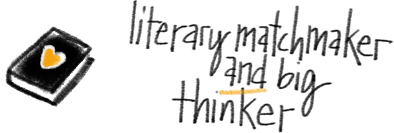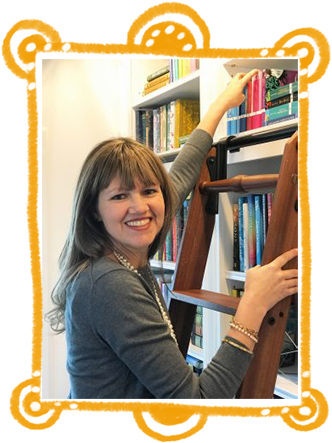
Armchair travel around the world!
Start your reading adventures with our FREE Reading Atlas.

- Around the World in 14 Books
- 7 Thrilling Book Series
- 6 Audiobooks That Are Like Theater For Your Ears



Pairing the right person with the best book for them is no mean feat. It’s a task that must be approached with all due precaution, a true heart, an open mind, and an understanding of both this particular human and that specific book.
Anne Bogel may be the master of literary match-making.
On her podcast What Should I Read Next?, she recommends books to a wide variety of readers by asking each guest the same telling question: What are three books you love and one book you hate?
Hearing other readers describe why they love the books they do — or don’t — is fascinating. While they talk, Anne listens and asks probing questions. Then she works her exclusive brand of alchemy to cough up recommendations that are not read-alikes but, instead, go straight to the heart of what her guests are really looking for between the covers of a book. It’s a little bit of psychology, lots of empathy, and wholly irresistible.
I was a guest on episode 60 of What Should I Read Next? back in 2017, and Anne’s recommendations for me were right on target. Now, we’ve challenged her to apply her literary wizardry to books with a strong sense of place. I think you’re going to love her suggestions. — Melissa

I enthusiastically recommend Rosamunde Pilcher’s The Shell Seekers, a sweeping family saga that revolves around the valuable, titular painting. Pilcher’s story of how greed can destroy an otherwise perfectly normal family moves between Cornwall and London, and between past and present, spanning the period from between the wars to Pilcher’s current day, the 1980s.
This novel whisked me away to England, and I couldn’t read quickly enough as I experienced life during the war—both in London and on the coast—through her characters’ eyes. The scenes set in Cornwall are the most vivid and most fascinating to this American reader. Pilcher grew up around the upper-class Bohemians of a Cornwall artists’ colony, and she drew heavily on her own experience to write this story. She says she aimed to write a ‘big, fat novel,’ and this one spans 600 admirably paced pages. As a reader, I was not only drawn into the story, I was also right there with the family as their story unfolded. It’s an immersive, satisfying read.
I’m an urban planning nerd, and I heartily recommend Jeff Speck’s nonfiction book Walkable City: How Downtown Can Save America, One Step at a Time for anyone who regularly finds themselves on city sidewalks. This may be the irresistible topic you didn’t know would suck you right in! Speck is a bit of a contrarian; at its heart, the book isn’t about walking at all. Instead, Speck aims to show how we can deliberately plan urban spaces to be useful, safe, comfortable, and engaging. At a deeper level, Speck reveals how our spaces shape our behavior, whether or not we’re aware of it.
The immediacy of his writing style makes you feel you’re there — walking down the city sidewalk, crossing the downtown intersection, attempting to parallel park in traffic. This presence makes you understand the topic in a whole new way. A pragmatic, relevant, and utterly fascinating read.
For a stylish, substantial mystery, try The Widows of Malabar Hill by Sujata Massey. Her protagonist Perveen Mistry is Bombay’s first female solicitor, employed by her father’s respected firm. When her father’s Muslim client dies, he is tasked with executing the will, but the three devout widows’ stay behind the veil,’ and must not be seen by men. When the father-daughter duo discovers irregularities in the estate documents, Perveen resolves to speak with the widows, because — as a woman — she’s the only one who can.
Perveen is determined to protect their interests, not just because of her legal obligations but because of a disastrous past marriage, where she experienced first-hand the cruelty women were made to endure under the law. Toss in a murder investigation, and you get a tightly-crafted mystery, a vividly-drawn multicultural setting, and a plucky heroine fiercely taking on the challenges of her time. The descriptions of the food alone will have you dreaming of old Bombay.

I’m a huge Marisa de los Santos fan; I appreciate that while sad things happen in her books, it’s clear she wants to leave the reader feeling happy. I recommend everything she writes, but for a strong sense of place I’ll Be Your Blue Sky is my first choice. In it, de los Santos brings back characters from previous books, but her loose series of books needn’t be read in order. The day before her wedding, Clare has cold feet. Enter Edith, an elderly stranger with whom Clare with instantly feels a connection — and who nudges Clare to cancel her wedding to a man who scares her. Not long after, Clare receives notice that Edith has died and bequeathed her a strange gift: a house. And oh, what a glorious setting this house turns out to be! I can’t think of the book without picturing myself in it. Clare seeks refuge in this house after her non-wedding, and soon learns hints of the past role the house — and Edith — played in a ‘relocation system’ that served women fleeing domestic violence in the 1950s.
The story jumps back and forth in time between Clare’s current dilemma and the 1950s mystery. This novel is easy reading while covering serious emotional territory, and it’s packed with literary references that will warm book lovers’ hearts.
Jane Steele by Lindsay Faye! Relax, Jane Eyre-lovers: While Faye — and her heroine, Jane Steele — draw serious inspiration from the Brontë classic, this is not a retelling of Jane Eyre. Instead, it’s delightfully meta. Our titular narrator tells us the inspiration to write her own story came from ‘the most riveting book titled Jane Eyre.’ This Jane — the Steele-y one — is a wise-cracking, whipsmart, unconventional young woman who rebels against Victorian convention, but she has a heart of gold. There are numerous sly winks to the original novel: Jane Steele becomes a governess. There’s a stand-in for Mr. Rochester. And, of course, something important is locked away in an attic. It’s perfect for readers who love plucky Victorian heroines like the ones you’d find in Deanna Raybourn novels.
I’ve gotta go with an Alaskan novel: The Snow Child by Eowyn Ivey. The book opens in Alaska, 1920. It’s the night of the first snowfall, and a usually serious couple is inspired to indulge in a bit of silliness: They build a child out of snow, just for fun. In the morning, the snow child is gone. But in a way that eerily mirrors a much-loved fairy tale, the couple spies a young girl they’ve never seen before running through the snowy trees. I loved this magic-infused story about love, loss, and the wildness of nature.



Top image courtesy of Nutnaree Saingwongwattana.
Want to keep up with our book-related adventures? Sign up for our newsletter!
Can you help us? If you like this article, share it your friends!
Strong Sense of Place is a website and podcast dedicated to literary travel and books we love. Reading good books increases empathy. Empathy is good for all of us and the amazing world we inhabit.
Strong Sense of Place is a listener-supported podcast. If you like the work we do, you can help make it happen by joining our Patreon! That'll unlock bonus content for you, too — including Mel's secret book reviews and Dave's behind-the-scenes notes for the latest Two Truths and a Lie.
Join our Substack to get our FREE newsletter with podcast updates and behind-the-scenes info — and join in fun chats about books and travel with other lovely readers.

We'll share enough detail to help you decide if a book is for you, but we'll never ruin plot twists or give away the ending.
Content on this site is ©2026 by Smudge Publishing, unless otherwise noted. Peace be with you, person who reads the small type.